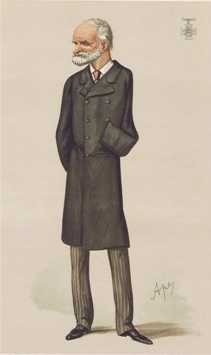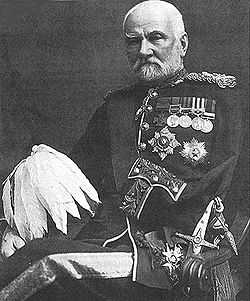Sam Browne
| Sam Browne | |
|---|---|
|
General Browne in 1897 | |
| Born |
3 October 1824 Barrackpore, British India |
| Died |
14 March 1901 (aged 76) Ryde, Isle of Wight |
| Buried at | Town Cemetery, Ryde |
| Allegiance |
|
| Service/branch |
Bengal Army British Indian Army |
| Rank | General |
| Battles/wars |
Indian Mutiny Second Anglo-Afghan War |
| Awards |
Victoria Cross Order of the Bath Order of the Star of India |
| Other work | Inventor of the Sam Browne belt |
General Sir Samuel James Browne VC GCB KCSI (3 October 1824 – 14 March 1901) was a British Indian Army cavalry officer in India[1] and Afghanistan, best known today as the namesake of the Sam Browne belt. He was a British recipient of the Victoria Cross, the highest and most prestigious award for gallantry in the face of the enemy that can be awarded to British and Commonwealth forces.
Early life
He was born in Barrackpore, India, the son of Dr. John Browne, a surgeon in the Bengal Medical Service and his wife Charlotte (née Swinton). Browne joined the 46th Bengal Native Infantry as a subaltern, participating in action at Ramnuggar, Sadoolapore, Chillianwalla and Gujarat. In 1849 he was made a lieutenant and tasked with raising a cavalry force, to be designated the 2nd Punjab Irregular Cavalry and later incorporated into the regular force. He would command this unit for the next five years. Later (1904) the unit would be re-designated as the 22nd Sam Browne's Cavalry (Frontier Force) in his honour.
Indian Mutiny
Browne led the 2nd Punjab in several engagements, and was decorated for action during the Bozdar Expedition in 1857, being promoted to captain.
Browne was awarded the Victoria Cross for actions on 31 August 1858 at Seerporah, Rohilkhand, Uttar Pradesh, India. His citation reads:
| “ | For having at Seerporah, in an engagement with the Rebel Forces under Khan Allie Khan, on the 31st of August, 1858, whilst advancing upon the Enemy's position, at day break, pushed on with one orderly Sowar upon a nine-pounder gun that was commanding one of the approaches to the enemy's position, and attacked the gunners, thereby preventing them from re-loading, and firing upon the Infantry, who were advancing to the attack. In doing this, a personal conflict ensued, in which Captain, now Lieutenant -Colonel, Samuel James Browne, Commandant of the 2nd Punjab Cavalry, received a severe sword-cut wound on the left knee, and shortly afterwards another sword-cut wound, which severed the left arm at the shoulder, not, however, before Lieutenant-Colonel Browne had succeeded in cutting down one of his assailants. The gun was prevented from being re-loaded, and was eventually captured by the Infantry, and the gunner slain. | ” |
| —London Gazette[2] | ||
His Victoria Cross is displayed at the National Army Museum.
Sam Browne belt

Sometime after this incident he began to wear the accoutrement which bears his name, as compensation for the difficulty his disability caused with wearing his officer's sword. Later the wearing of the Sam Browne belt would be adopted by other officers who knew Browne in India, but it was not to come into common use in the British Army until after his retirement.
Browne's original belt is held by the National Army Museum in Chelsea.
Second Anglo-Afghanistan War
In 1878, as commander of the Peshawar Field Force during the Second Afghan War Browne brought 16,000 troops and 48 guns to the Khyber Pass, capturing the key fortress of Ali Masjid, which commanded its entry, and afterward proceeding through the pass and capturing Jalalabad. Browne was made a Knight Commander of the Order of the Bath for this action.
Browne was promoted to general in 1878, and awarded the Order of the Bath's Grand Cross in 1891.
Later life
He retired from the army in 1898, relocated to Ryde on the Isle of Wight, England and died there at the age of 76. His remains were cremated but there is a memorial marker dedicated to Browne in the Ryde New Cemetery, as well as plaques at St Paul's Cathedral and Lahore Cathedral. His grave was restored in 2010.
Footnotes
- ↑ Sam Browne Belt
- ↑ The London Gazette: no. 22485. p. 1007. 1 March 1861. Retrieved 26 September 2009.
External references
- Monuments to Courage (David Harvey, 1999)
- The Register of the Victoria Cross (This England, 1997)
External links
| Wikimedia Commons has media related to Sir Samuel James Browne. |
- Location of grave and VC medal (Isle of Wight)
